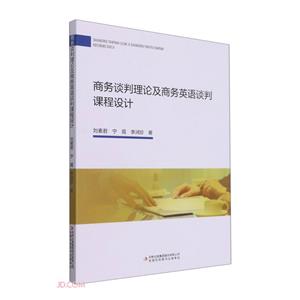
作者:赵晓华
页数:219
出版社:中国社会科学出版社
出版日期:2012
ISBN:9787516118993
电子书格式:pdf/epub/txt
内容简介
《汉语谈判中的模糊语言》编著者赵晓华、张乔。《汉语谈判中的模糊语言》内容提要:人们为什么使用模糊语言(例如“许多”,“一点儿”)?人们又是如何使用模糊语言的?通过研究作为中文商务谈判交际策略的模糊语言,我们在本书中探讨上述问题。本研究有别于以往研究的三方面为:1)使用真实、自然的商务谈判语料;2)从词法、句法、语流、语用等多个视角分析研究;3)把社会、文化因素作为相关参数融人到对模糊语言的分析中。本研究发现,从普及性和有效性来看,模糊语言不但不比非模糊语言逊色,而是可能更出色,因此人们往往更喜欢使用模糊语言。当出于实用性和融洽人际关系这两个目的使用模糊语言时,前者比后者用得多而广。模糊语言的运用在不同程度上受到年龄、亲疏、性别的影响。本书是研究模糊语言在真实的中文商务谈判中如何运用的初次尝试之一,为模糊语言和语言交际的研究增添了重要的内容,并对汉语的模糊性及其有效运用的启示提出了见解。本书可作为从事语言学、语言研究、语言交际学以及跨文化研究的学者和研究生的参考资料,也可供从事语言教学、跨文化教育、语言交际专业培训的教育工作者、以及对语言与语言交际感兴趣的读者使用。
本书特色
《汉语谈判中的模糊语言》共分为九章,是研究模糊语言在真实的中文商务谈判中如何运用的初次尝试之一,为模糊语言和语言交际的研究增添了重要的内容,并对汉语的模糊性及其有效运用的启示提出了见解。
《汉语谈判中的模糊语言》可作为从事语言学、语言研究、语言交际学以及跨文化研究的学者和研究生的参考资料,也可供从事语言教学、跨文化教育、语言交际专业培训的教育工作者、以及对语言与语言交际感兴趣的读者使用。
目录
chapter 1 introduction
1.1 motivation for the study
1.2 purpose of the study
1.3 approach and methodology
1.4 organization of the book
chapter 2 theoretical foundations
2.1 definitions of vl
2.2 the development of vl studies
2.3 linguistic vagueness
2.3.1 vl as an integral part of language
2.3.2 pragmatic roles of vl
2.3.3 interactive aspects of vl
2.4 business communication and vl
2.4.1 business communication
2.4.2 the use of vl in business communication
2.5 vl in social contexts
2.6 other perspectives of vl studies
2.7 conversation analysis
chapter 3 methodology
3.1 data collection
3.2 data analysis
3.3 coding system
chapter 4 analysis of parts of speech at the lexical level
4.1 negotiation 1
4.1.1 parts of speech of the ves
4.1.2 lexical analysis
4.1.3 overall findings of negotiation 1
4.2 negotiation 2
4.2.1 parts of speech of the ves
4.2.2 lexieal analysis
4.2.3 overall findings of negotiation 2
4.3 negotiation 3
4.3.1 parts of speech of the ves
4.3.2 lexical analysis
4.3.3 overall findings of negotiation 3
4.4 negotiation 4
4.4.1 parts of speech of theves
4.4.2 lexieal analysis
4.4.3 overall findings of negotiation 4
4.5 negotiation 5
4.5.1 parts of speech of theves
4.5.2 lexieal analysis
4.5.3 overall findings of negotiation 5
4.6 summarizing remarks
4.6.1 general discussion
4.6.2 social factor comparison
chapter 5 combinational analysis at the lexical level
5.1 pre-vaguefiers
5.2 vague expressions
5.3 post-vaguefiers
5.4 summarizing remarks
chapter 6 vagueness at the syntactic level
6.1 negotiation 1
6.1.1 frequency of types of syntactical vagueness
6.1.2 syntactic analysis
6.1.3 overall findings of negotiation 1
6.2 negotiation 2
6.2.1 frequency of types of syntactical vagueness
6.2.2 syntactic analysis
6.2.3 overall findings of negotiation 2
6.3 negotiation 3
6.3.1 frequency of types of syntactical vagueness
6.3.2 syntactic analysis
6.3.3 overall findings of negotiation 3
6.4 negotiation 4
6.4.1 frequency of types of syntactical vagueness
6.4.2 syntactic analysis
6.4.3 overall findings of negotiation 4
6.5 negotiation 5
6.5.1 frequency of types of syntactical vagueness
6.5.2 syntactic analysis
6.5.3 overall findings of negotiation 5
6.6 summarizing remarks
chapter 7 pragmatic analysis
7.1 self-protection
7.1.1 contextualized analysis
7.1.2 social factor comparison
7.2 deliberately withholding information
7.2.1 contextualized analysis
7.2.2 social factor comparison
7.3 politeness
7.3.1 contextualized analysis
7.3.2 social factor comparison
7.4 informality
7.4.1 contextualized analysis
7.4.2 social factor comparison
7.5 filling in lexical gaps
7.5.1 contextualized analysis
7.5.2 social factor comparison
7.6 giving the right amount of information
7.6.1 contextualized analysis
7.6.2 social factor comparison
7.7 summarizing remarks
chapter 8 sequential analysis of vl
8.1 sequential organization using vl
8.1.1 analysis of sequential organization
8.1.2 summary of sequential organization
8.2 sequential strategies through the employment of vl
8.2.1 analysis of sequential strategies
8.2.2 summary of sequential strategies
8.3 summarizing remarks
chapter 9 conclusions and implications
9. 1 lexical patterns of vl
9.2 syntactic forms of vl
9.3 pragmatic functions of vl
9.4 interaction using vl
9.5 the influence of social factors
9.6 implications
9.6.1 chinese business communication
9.6.2 chinese language education
9.6.3 intercultural communication
9.6.4 professional training
references
节选
《汉语谈判中的模糊语言》可作为从事语言学、语言研究、语言交际学以及跨文化研究的学者和研究生的参考资料,也可供从事语言教学、跨文化教育、语言交际专业培训的教育工作者、以及对语言与语言交际感兴趣的读者使用。















